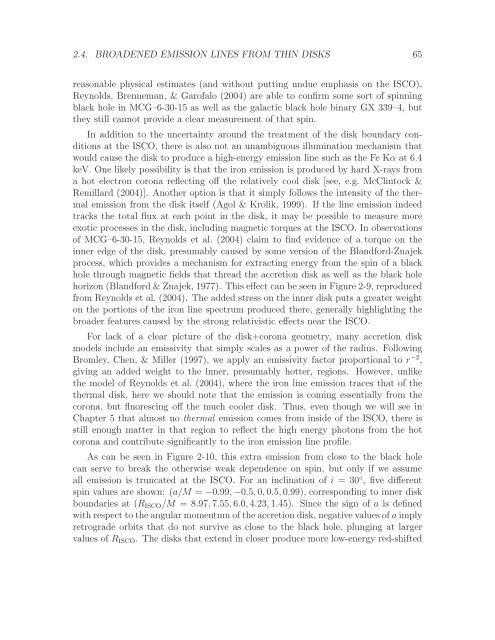Radiation Transport Around Kerr Black Holes Jeremy David ...
Radiation Transport Around Kerr Black Holes Jeremy David ...
Radiation Transport Around Kerr Black Holes Jeremy David ...
You also want an ePaper? Increase the reach of your titles
YUMPU automatically turns print PDFs into web optimized ePapers that Google loves.
2.4. BROADENED EMISSION LINES FROM THIN DISKS 65<br />
reasonable physical estimates (and without putting undue emphasis on the ISCO),<br />
Reynolds, Brenneman, & Garofalo (2004) are able to confirm some sort of spinning<br />
black hole in MCG–6-30-15 as well as the galactic black hole binary GX 339–4, but<br />
they still cannot provide a clear measurement of that spin.<br />
In addition to the uncertainty around the treatment of the disk boundary conditions<br />
at the ISCO, there is also not an unambiguous illumination mechanism that<br />
would cause the disk to produce a high-energy emission line such as the Fe Kα at 6.4<br />
keV. One likely possibility is that the iron emission is produced by hard X-rays from<br />
a hot electron corona reflecting off the relatively cool disk [see, e.g. McClintock &<br />
Remillard (2004)]. Another option is that it simply follows the intensity of the thermal<br />
emission from the disk itself (Agol & Krolik, 1999). If the line emission indeed<br />
tracks the total flux at each point in the disk, it may be possible to measure more<br />
exotic processes in the disk, including magnetic torques at the ISCO. In observations<br />
of MCG–6-30-15, Reynolds et al. (2004) claim to find evidence of a torque on the<br />
inner edge of the disk, presumably caused by some version of the Blandford-Znajek<br />
process, which provides a mechanism for extracting energy from the spin of a black<br />
hole through magnetic fields that thread the accretion disk as well as the black hole<br />
horizon (Blandford & Znajek, 1977). This effect can be seen in Figure 2-9, reproduced<br />
from Reynolds et al. (2004). The added stress on the inner disk puts a greater weight<br />
on the portions of the iron line spectrum produced there, generally highlighting the<br />
broader features caused by the strong relativistic effects near the ISCO.<br />
For lack of a clear picture of the disk+corona geometry, many accretion disk<br />
models include an emissivity that simply scales as a power of the radius. Following<br />
Bromley, Chen, & Miller (1997), we apply an emissivity factor proportional to r −2 ,<br />
giving an added weight to the inner, presumably hotter, regions. However, unlike<br />
the model of Reynolds et al. (2004), where the iron line emission traces that of the<br />
thermal disk, here we should note that the emission is coming essentially from the<br />
corona, but fluorescing off the much cooler disk. Thus, even though we will see in<br />
Chapter 5 that almost no thermal emission comes from inside of the ISCO, there is<br />
still enough matter in that region to reflect the high energy photons from the hot<br />
corona and contribute significantly to the iron emission line profile.<br />
As can be seen in Figure 2-10, this extra emission from close to the black hole<br />
can serve to break the otherwise weak dependence on spin, but only if we assume<br />
all emission is truncated at the ISCO. For an inclination of i = 30 ◦ , five different<br />
spin values are shown: (a/M = −0.99, −0.5, 0, 0.5, 0.99), corresponding to inner disk<br />
boundaries at (R ISCO /M = 8.97, 7.55, 6.0, 4.23, 1.45). Since the sign of a is defined<br />
with respect to the angular momentum of the accretion disk, negative values of a imply<br />
retrograde orbits that do not survive as close to the black hole, plunging at larger<br />
values of R ISCO . The disks that extend in closer produce more low-energy red-shifted
















